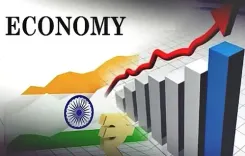Should Gold Be Excluded from India’s Core Inflation Index?

Synopsis
Key Takeaways
- Gold inflation significantly affects core inflation metrics.
- Excluding gold could provide a clearer view of domestic demand pressures.
- Global economic uncertainty drives up gold prices.
- Core CPI inflation increased significantly in recent years.
- Central banks handle gold inflation differently than India.
New Delhi, June 18 (NationPress) A recent report by Crisil has proposed that, akin to the exclusions of food and fuel from the core inflation index, gold should also be omitted when evaluating the genuine effects of domestic demand pressures on pricing. This is especially pertinent during times of significant global economic uncertainty when gold prices often escalate.
The analysis indicated that gold inflation, despite its relatively modest weight of 2.3 percent in the core inflation index, was responsible for a striking 17 percent of the increase in core inflation over the 12-month period ending in May 2025.
“In fiscal 2025, gold inflation surged to an average of 24.7 percent compared to 15.1 percent in fiscal 2024, while other categories that deviated from this trend recorded a mere 2.4 percent combined inflation rate,” the report contended.
Between May 2024 and May 2025, core CPI inflation rose by 111 basis points to 4.2 percent. Although most subcategories within core inflation saw declines, five areas experienced rising inflation: mobile tariffs, travel and transport, toiletries, silver, and gold.
Among these, gold experienced the most substantial inflation increase. Global prices surged due to rising safe-haven investment demand amid heightened global economic uncertainty.
“Even though gold comprises a small portion of the headline CPI (1.1 percent of the total index), its inclusion in the core CPI calculation can distort domestic price signals, particularly in times of global economic instability,” the Crisil report elaborated.
Typically, rising core inflation indicates underlying domestic demand pressures on prices. However, since gold prices are predominantly affected by global factors—especially safe-haven investment demand—they do not accurately reflect domestic consumption trends, it added.
In times of global uncertainty, such as now, gold prices can distort the trajectory of core inflation, warranting its exclusion from analysis.
“For example, had gold prices adhered to their usual trends, core inflation would have registered at 3.4 percent in May instead of the reported 4.2 percent. Excluding gold shows that the core CPI increased by only 65 basis points over the 12 months ending in May 2025, compared to the 111 basis points rise in the conventional core measure,” the report emphasized.
Notably, many central banks also incorporate gold in their core inflation index, but its weight is significantly lower than that in India, which limits its influence on their core inflation measures. In India, the higher weight of gold may be attributed to its more significant share in consumption compared to other nations.








